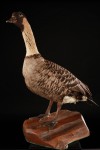Western Capercaillie – Tetrao urogallus
Western Capercaillie – Urogallus
The western capercaillie is a gallinaceous of coniferous forests that can not be confused because of its massive head and neck, broad tail that fans out like a turkey with short legs but very robust. There is a sexual dimorphism both evident from the point of view of the size of the color. The male has a black-brown plumage with green and purple hues. Some white spots dotting the tail feathers are rounded. The beak is white and a red bare skin area identifies the top and back of the eyes. The throat feathers are ruffled and form a small beard. A small white spot blotch the leading edge of the wing.
Capercaillie lives mainly in northern and eastern Europe, Scandinavia and Russia. Its usual habitat is the taiga coniferous forests and mixed forests. It deserted in general spruce monocultures because it needs clearings with blueberries, rowan trees and a mixture of all ages.
Shy and cautious, it is easier to observe in spring when parading males. Courtship displays are spectacular and take place in a specific place prepared for this purpose. Typically, the capercaillie flies quietly and with great agility between the trees but it can fly with noisy wing beats if surprised.
The nest is a hollow ground lined with grass and leaves. In June or July, the female lays 5 to 9 eggs. The chicks hatch after 4 weeks of incubation.
Capercaillie occasionally hybridizes with the black grouse and even with the pheasant in range limit, where the numbers are small and the few potential partners.
It has a predominantly vegetarian products. It consumes pine needles, buds, leaves, berries but also ants and beetles, gravel that facilitate digestion, it is a granivorous and its lifetime is estimated at 10 years.
It is threatened by habitat modification.





